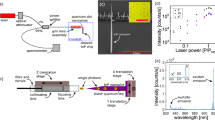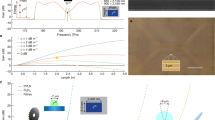Abstract
Fibre-optic components fabricated on the same substrate as integrated circuits are important for future high-speed communications. One industry response has been the costly push to develop indium phosphide (InP) electronics. However, for fabrication simplicity, reliability and cost, gallium arsenide (GaAs) remains the established technology for integrated optoelectronics. Unfortunately, the GaAs bandgap wavelength (0.85 μm) is far too short for fibre optics at 1.3–1.5 μm. This has led to work on materials that have a large lattice mismatch on GaAs. Here we demonstrate the first light-emitting diode (LED) that emits at 1.5 μm fibre-optic wavelengths in GaAs using optical transitions from arsenic antisite (AsGa) deep levels. This is an enabling technology for fibre-optic components that are lattice-matched to GaAs integrated circuits. We present experimental results showing significant internal optical power (24 mW) and speed (in terahertz) from GaAs optical emitters using deep-level transitions. Finally, we present theory showing the ultimate limit to the efficiency-bandwidth product of semiconductor deep-level optical emitters.
This is a preview of subscription content, access via your institution
Access options
Subscribe to this journal
Receive 12 print issues and online access
$259.00 per year
only $21.58 per issue
Buy this article
- Purchase on Springer Link
- Instant access to full article PDF
Prices may be subject to local taxes which are calculated during checkout




Similar content being viewed by others
References
Melloch, M.R. et al. Low-temperature grown III-V materials. Ann. Rev. Mater. Sci. 25, 547–600 ( 1995).
Melloch, M.R. et al. Molecular beam epitaxy of nonstoichiometric semiconductors and multiphase material systems. Crit. Rev. Solid State Mater. Sci. 21, 189–263 ( 1996).
Pan, J.L. Optical emission from bound states of semiconductor deep-centres. Opt. Express 9, 796–805 ( 2001).
Pan, J.L. Analytical method for finding the general optical properties of semiconductor deep centres. J. Appl. Phys. 92, 5991–6004 ( 2002).
Agrawal, G.P. & Dutta, N.K. Long Wavelength Semiconductor Lasers 225, 244–247 (Van Nostrand Reinhold, New York, 1986).
Siegman, A.E. Lasers 119, 958, 962–964 (University Science Books, Mill Valley, California, 1986).
Marcuse, D. & Lee, T.P. On approximate analytical solutions of rate equations for studying transient spectra of injection lasers. IEEE J. Quantum Electr. 19, 1397–1406 ( 1983).
Feenstra, R.M. Cross-sectional scanning tunneling microscopy of III-V semiconductor structures. Semicond. Sci. Techol. 9, 2157–2168 ( 1994).
Feenstra, R.M., Woodall, J.M. & Pettit, G.D. Observation of bulk defects by scanning tunneling microscopy and spectroscopy: Arsenic antisites defects in GaAs. Phys. Rev. Lett. 71, 1176–1179 ( 1993).
Grandidier, B. et al. Scanning tunneling microscopy and spectroscopy of arsenic antisites in low-temperature grown InGaAs. Appl. Phys. Lett. 74, 1439–41 ( 1999).
Baraff, G.A. & Schluter, M.A. Electronic aspects of the optical-absorption spectrum of the EL2 defect in GaAs. Phys. Rev. B 45, 8300–8309 ( 1992).
Faist, J. et al. Quantum cascade laser. Science 264, 553–556 ( 1994).
Faist, J. et al. Mid-infrared field-tunable intersubband electroluminescence at room temperature by photon-assisted tunneling in coupled-quantum wells. Appl. Phys. Lett. 64, 1144–1146 ( 1994).
Acknowledgements
We thank R. D. Grober for the use of his FTIR equipment for absorption measurements. J.L.P. was supported by National Science Foundation CAREER.
Author information
Authors and Affiliations
Corresponding author
Ethics declarations
Competing interests
The authors declare no competing financial interests.
Rights and permissions
About this article
Cite this article
Pan, J., McManis, J., Osadchy, T. et al. Gallium arsenide deep-level optical emitter for fibre optics. Nature Mater 2, 375–378 (2003). https://doi.org/10.1038/nmat887
Received:
Accepted:
Published:
Issue Date:
DOI: https://doi.org/10.1038/nmat887
This article is cited by
-
Improvement of Terahertz Wave Radiation for InAs Nanowires by Simple Dipping into Tap Water
Scientific Reports (2016)
-
LEDs get on the right wavelength
Nature (2003)
-
A deep-level LED
Nature Materials (2003)



